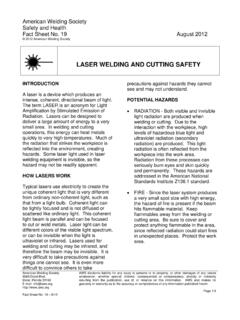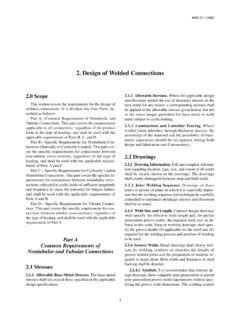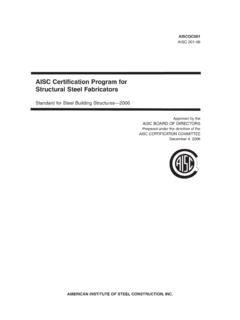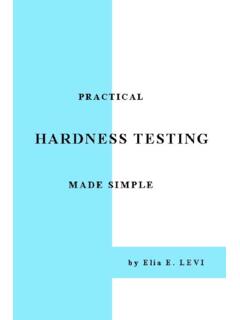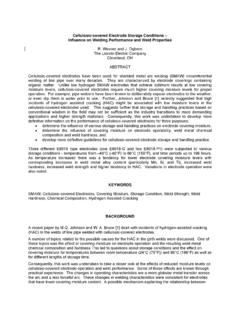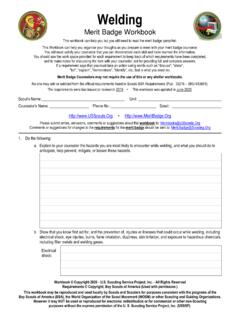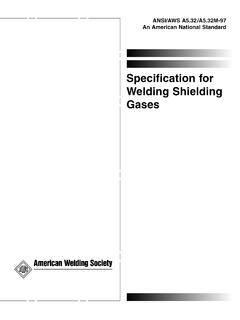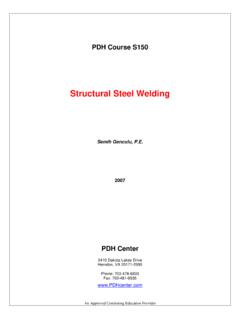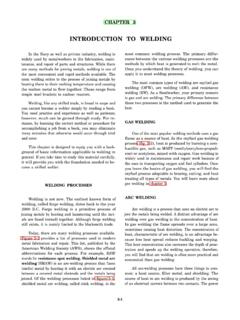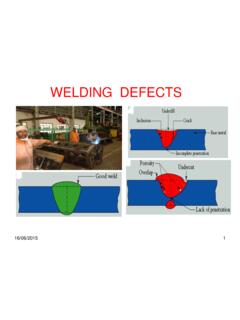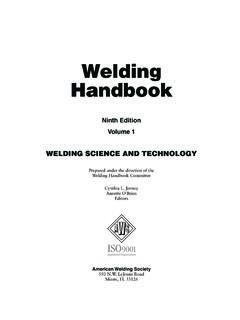Transcription of Cylinders: Safe Storage, Handling, and Use
1 Safety and Health Fact Sheet No. 30 April 2014 2014 American welding Society Cylinders: safe storage , handling , and Use American welding Society 8669 Doral Blvd. Doral, Florida 33166 E-mail: Fact Sheet No. 30 04/14 AWS disclaims liability for any injury to persons or to property, or other damages of any nature whatsoever, whether special, indirect, consequential or compensatory, directly or indirectly resulting from the publication, use of, or reliance on this information. AWS also makes no guaranty or warranty as to the accuracy or completeness of any information published herein.
2 Page 1/4 INTRODUCTION To use compressed gas cylinders safely, it is important that they are stored properly, handled correctly, used with the correct equipment, and that the properties of the gases they contain are fully understood. OVERVIEW OF cylinder PHYSICAL HAZARDS Physical Damage: Cylinders, with their high internal pressure [up to 2,500 pounds per square inch gauge (psig)], are very hazardous when exposed to damage from falling over or tipping, heat, electric circuits, motion, or vibration anything that can cause a weakness or crack in the cylinder wall or shell. Such damage can cause the cylinder to rupture and explode sending sharp metal pieces, like shrapnel, blasting through the area. Valve Hazard: The CGA (in Pamphlet V-1) has established a inch ( mm) maximum valve inlet diameter as a requirement to minimize the propulsion effect in case the valve is severed.
3 This standard has the exception of valves used in liquefied gas services and fire control systems. Special design requirements and unique applications such as fire control systems, which require a high blow down flow , may dictate greater diameters. The actual outcome of a broken off valve depends on the design and pressure of the valve and cylinder . If the valve is broken off and the valve inlet opening meets the Compressed Gas Association (CGA) requirements, the cylinder will rapidly release all its gas (which could be a health and/or flammability concern), cause a whistling sound, and possibly spin uncontrollably. If the valve inlet opening is different from the standard hole size used in most welding gases, such as those used for propane or butane and fire protection system cylinders, the cylinders may take off and become airborne.
4 You can check this size matter by being sure the cylinder meets all V-1 requirements. Tipping and Falling: The most common major hazard is having a cylinder tip over or fall on you or another nearby worker. Since cylinders are heavy and awkward to handle, they require special care and equipment in handling and securing so they don t fall or tip over and cause injury. Valve Leakage: cylinder valves can leak, causing their contents to discharge. To minimize hazards from leaks, use proper ventilation and storage . OVERVIEW OF cylinder CONTENTS HAZARDS Read, understand, and follow the markings on the cylinder , the label(s) on the cylinder , and the safety data sheet (SDS). Each compressed gas cylinder has unique American welding Society 8669 Doral Blvd.
5 Doral, Florida 33166 E-mail: Fact Sheet No. 30 04/14 AWS disclaims liability for any injury to persons or to property, or other damages of any nature whatsoever, whether special, indirect, consequential or compensatory, directly or indirectly resulting from the publication, use of, or reliance on this information. AWS also makes no guaranty or warranty as to the accuracy or completeness of any information published herein. Page 2/4 hazards based on contents. Some are filled with inert gases especially those used in arc welding . Many gases are flammable, explosive, toxic, or a combination. Common compressed gases include acetylene, carbon dioxide, argon, hydrogen, nitrogen, air, propane, and oxygen.
6 HOW TO STORE CYLINDERS Store cylinders upright and secure them with a chain, strap, or cable to a stationary building support or to a proper cylinder cart to prevent them from tipping or falling. Completely close the valves, and keep the valve protection devices, such as caps or guards, securely in place. Store cylinders in a dry, well-ventilated area at least 20 feet from combustible materials. Do not keep cylinders in lockers. If they leak, a buildup of flammable or other types of gases can occur inside the locker. Mark the storage area with proper precautionary signs, such as flammable, oxidizer, or toxic. Place them in a location where they will not be subject to mechanical or physical damage, heat, or electrical circuits to prevent possible explosion or fire.
7 Keep cylinders away from vehicle traffic. Store empty cylinders separate from full ones. Keep oxygen cylinders 20 feet away from fuel-gas cylinders, such as acetylene, or separate them with a non-combustible barrier (such as a wall) at least 5 feet high with a fire-resistance rating of at least one-half hour. HOW TO TRANSPORT CYLINDERS Most accidents or injuries involving cylinders happen when moving or handling the gas cylinders. Use the right equipment, correct procedures, and sufficient number of persons to lift and move cylinders to avoid personal injury and cylinder damage. Wear protective footwear, safety glasses, and heavy gloves. Securely install the valve protection devices, such as caps or guards.
8 Secure cylinders upright to a proper hand truck or cylinder cart designed for the purpose. Don't drag or roll them use a properly designed cart or hand truck. When using a crane, be sure to use proper cradles, nets, boats, or special platforms designed for this purpose to prevent cylinders from falling. Prevent damage handle carefully avoid dropping or banging them. Do not lift by the protective cap/guard or use magnets or slings to lift or move them since valves may be damaged or sheared off. American welding Society 8669 Doral Blvd. Doral, Florida 33166 E-mail: Fact Sheet No. 30 04/14 AWS disclaims liability for any injury to persons or to property, or other damages of any nature whatsoever, whether special, indirect, consequential or compensatory, directly or indirectly resulting from the publication, use of, or reliance on this information.
9 AWS also makes no guaranty or warranty as to the accuracy or completeness of any information published herein. Page 3/4 HOW TO USE CYLINDERS Follow the instructions in the Compressed Gas Association (CGA) publication P-1, safe handling of Compressed Gases in Cylinders. (The phone number and web site of the CGA are located at the end of this sheet in the Information Sources Section.) Don't tamper with safety devices. Keep cylinders upright and away from heat, sparks, fire, physical damage, or electrical circuits to avoid rupture. Use in a well-ventilated area to avoid gas accumulation. Do not bring cylinders into a confined space to avoid inhaling the gas and possible suffocation from the accumulation of flammable, toxic, or reactive gases.
10 Read, understand, and follow all cylinder markings and labels to avoid misuse. Before connecting a regulator, stand to one side, and momentarily open the valve and then close it immediately. This procedure, called cracking the valve, is done to clear the valve of dust or dirt that could enter the regulator. Open valves slowly by hand to avoid gauge damage. If a specific tool is required to open the valve, leave it in position so that the flow of gas can be stopped quickly in an emergency. Lift and move cylinders properly. Close the gas cylinder valves when not in use such as during breaks, lunch, or end-of-shift to avoid leaks. Avoid getting any oil or grease on the cylinders or regulators/gauges, particularly those containing oxygen, to avoid fire or explosion.
